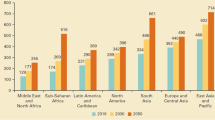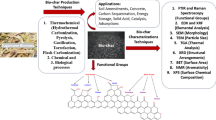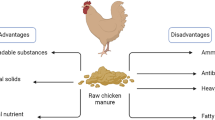Abstract
Purpose
The feasibility of coupling the anaerobic digestion of pig manure and co-pyrolysis of its digestate with milk thistle as lignocellulosic biomass was studied. Kinetic analysis was performed along with an evaluation of energy recovery attained from a combined approach
Methods
Pig slurry was digested under mesophilic semi-continuous conditions. Digestate was dried and submitted to thermogravimetric analysis under inert atmosphere along with milk thistle samples. Kinetic evaluation was carried out using non-isothermal methods. Assessment of the energy obtained from the combined digestion and pyrolysis process was performed.
Results
Digestion resulted in a yield of 308.5 ± 18.2 mL CH4/g VS. The evaluation of co-pyrolysis of mixtures at different contents of milk thistle showed no interactions between the two materials during pyrolysis. The energy need associated with thermal drying of digestate was 476 MJ/m3 of pig slurry.
Conclusions
Co-pyrolysis of lignocellulosic biomass and digestate [25% content of digestate (w/w)] resulted in a lower char production, associated with the lower ash content of the former. The extra supply of energy needed for thermal drying of the digestate might be obtained from co-pyrolysis with biomass. This approach presented an energy recovery of about 29.4%
Graphic Abstract







Similar content being viewed by others
References
Singh, R.P., Ibrahim, M.H., Esa, N., Iliyana, M.S.: Composting of waste from palm oil mill: a sustainable waste management practice. Rev. Environ. Sci. Bio/Technol. 9, 331–344 (2010). https://doi.org/10.1007/s11157-010-9199-2
de la Fuente, C., Alburquerque, J.A., Clemente, R., Bernal, M.P.: Soil C and N mineralisation and agricultural value of the products of an anaerobic digestion system. Biol. Fertil. Soils. 49, 313–322 (2013). https://doi.org/10.1007/s00374-012-0719-9
Yuan, Z., Pan, X., Chen, T., Liu, X., Zhang, Y., Jiang, S., Sheng, H., Zhang, L.: Evaluating environmental impacts of pig slurry treatment technologies with a life-cycle perspective. J. Clean. Prod. 188, 840–850 (2018). https://doi.org/10.1016/j.jclepro.2018.04.021
Riya, S., Suzuki, K., Meng, L., Zhou, S., Terada, A., Hosomi, M.: The influence of the total solid content on the stability of dry-thermophilic anaerobic digestion of rice straw and pig manure. Waste Manag. 76, 350–356 (2018). https://doi.org/10.1016/j.wasman.2018.02.033
Risberg, K., Cederlund, H., Pell, M., Arthurson, V., Schnürer, A.: Comparative characterization of digestate versus pig slurry and cow manure—chemical composition and effects on soil microbial activity. Waste Manag. 61, 529–538 (2017). https://doi.org/10.1016/j.wasman.2016.12.016
Trippe, F., Fröhling, M., Schultmann, F., Stahl, R., Henrich, E.: Techno-economic analysis of fast pyrolysis as a process step within biomass-to-liquid fuel production. Waste Biomass Valori. 1, 415–430 (2010). https://doi.org/10.1007/s12649-010-9039-1
Vamvuka, D., Sfakiotakis, S.: Thermal behaviour and reactivity of swine sludge and olive by-products during co-pyrolysis and co-combustion. Waste Biomass Valori. (2017). https://doi.org/10.1007/s12649-017-0118-4
Hawash, S.I., Farah, J.Y., El-Diwani, G.: Pyrolysis of agriculture wastes for bio-oil and char production. J. Anal. Appl. Pyrolysis. 124, 369–372 (2017). https://doi.org/10.1016/j.jaap.2016.12.021
Wei, Y., Hong, J., Ji, W.: Thermal characterization and pyrolysis of digestate for phenol production. Fuel 232, 141–146 (2018). https://doi.org/10.1016/j.fuel.2018.05.134
Gumisiriza, R., Hawumba, J.F., Okure, M., Hensel, O.: Biomass waste-to-energy valorisation technologies: a review case for banana processing in Uganda. Biotechnol. Biofuels. 10, 11 (2017). https://doi.org/10.1186/s13068-016-0689-5
Mao, G., Huang, N., Chen, L., Wang, H.: Research on biomass energy and environment from the past to the future: a bibliometric analysis. Sci. Total Environ. 635, 1081–1090 (2018). https://doi.org/10.1016/j.scitotenv.2018.04.173
Cao, Y., Pawłowski, A.: Sewage sludge-to-energy approaches based on anaerobic digestion and pyrolysis: Brief overview and energy efficiency assessment. Renew. Sustain. Energy Rev. 16, 1657–1665 (2012). https://doi.org/10.1016/J.RSER.2011.12.014
Fabbri, D., Torri, C.: Linking pyrolysis and anaerobic digestion (Py-AD) for the conversion of lignocellulosic biomass. Curr. Opin. Biotechnol. 38, 167–173 (2016). https://doi.org/10.1016/J.COPBIO.2016.02.004
Ledda, L., Deligios, P.A., Farci, R., Sulas, L.: Biomass supply for energetic purposes from some Cardueae species grown in Mediterranean farming systems. Ind. Crops Prod. 47, 218–226 (2013). https://doi.org/10.1016/J.INDCROP.2013.03.013
Bernal, M.P., Gómez, X., Chang, R., Arco-Lázaro, E., Clemente, R.: Strategies for the use of plant biomass obtained in the phytostabilisation of trace-element-contaminated soils. Biomass Bioenerg. 126, 220–230 (2019). https://doi.org/10.1016/j.biombioe.2019.05.017
Domínguez, M.T., Montiel-Rozas, M.M., Madejón, P., Díaz, M.J., Madejón, E.: The potential of native species as bioenergy crops on trace-element contaminated Mediterranean lands. Sci. Total Environ. 590–591, 29–39 (2017). https://doi.org/10.1016/j.scitotenv.2017.03.018
APHA: Standard Methods for the Examination of Water and Wastewater, 20th edn. American Public Health Association, Washington DC (1998)
Dahiya, J.B., Kumar, K., Muller-Hagedorn, M., Bockhorn, H.: Kinetics of isothermal and non-isothermal degradation of cellulose: model-based and model-free methods. Polym. Int. 57, 722–729 (2008). https://doi.org/10.1002/pi.2398
Cruz, G., Crnkovic, P.M.: Investigation into the kinetic behavior of biomass combustion under N2/O2 and CO2/O2 atmospheres. J. Therm. Anal. Calorim. 123, 1003–1011 (2016). https://doi.org/10.1007/s10973-015-4908-2
Ozawa, T.: A new method of analyzing thermogravimetric data. Bull. Chem. Soc. Jpn. 38, 1881–1886 (1965). https://doi.org/10.1246/bcsj.38.1881
Flynn, J.H., Wall, L.A.: A quick, direct method for the determination of activation energy from thermogravimetric data. J. Polym. Sci. Part B 4, 323–328 (1966). https://doi.org/10.1002/pol.1966.110040504
Doyle, C.D.: Estimating isothermal life from thermogravimetric data. J. Appl. Polym. Sci. 6, 639–642 (1962). https://doi.org/10.1002/app.1962.070062406
Vyazovkin, S.: Evaluation of activation energy of thermally stimulated solid-state reactions under arbitrary variation of temperature. J. Comput. Chem. 18, 393–402 (1997). https://doi.org/10.1002/(SICI)1096-987X(199702)18:3%3c393:AID-JCC9%3e3.0.CO;2-P
Otero, M., Calvo, L.F., Gil, M.V., García, A.I., Morán, A.: Co-combustion of different sewage sludge and coal: a non-isothermal thermogravimetric kinetic analysis. Bioresour. Technol. 99, 6311–6319 (2008). https://doi.org/10.1016/J.BIORTECH.2007.12.011
Sanchez, M.E., Otero, M., Gómez, X., Morán, A.: Thermogravimetric kinetic analysis of the combustion of biowastes. Renew. Energ. 34, 1622–1627 (2009). https://doi.org/10.1016/J.RENENE.2008.11.011
Gianico, A., Braguglia, C.M., Gallipoli, A., Mininni, G.: Innovative two-stage mesophilic/thermophilic anaerobic degradation of sonicated sludge: performances and energy balance. Environ. Sci. Pollut. R. 22, 7248–7256 (2015). https://doi.org/10.1007/s11356-014-3123-1
Zupančič, G.D., Roš, M.: Heat and energy requirements in thermophilic anaerobic sludge digestion. Renew. Energ. 28, 2255–2267 (2003). https://doi.org/10.1016/S0960-1481(03)00134-4
Salman, C.A., Schwede, S., Thorin, E., Yan, J.: Predictive modelling and simulation of integrated pyrolysis and anaerobic digestion process. Energy Proc. 105, 850–857 (2017). https://doi.org/10.1016/j.egypro.2017.03.400
Monlau, F., Sambusiti, C., Antoniou, N., Barakat, A., Zabaniotou, A.: A new concept for enhancing energy recovery from agricultural residues by coupling anaerobic digestion and pyrolysis process. Appl. Energy 148, 32–38 (2015). https://doi.org/10.1016/j.apenergy.2015.03.024
Titiladunayo, I.F., McDonald, A.G., Fapetu, O.P.: Effect of temperature on biochar product yield from selected lignocellulosic biomass in a pyrolysis process. Waste Biomass Valori. 3, 311–318 (2012). https://doi.org/10.1007/s12649-012-9118-6
Abnisa, F., Arami-Niya, A., Daud, W.W., Sahu, J.N.: Characterization of bio-oil and bio-char from pyrolysis of palm oil wastes. BioEnerg. Res. 6, 830–840 (2013). https://doi.org/10.1007/s12155-013-9313-8
Mullen, C.A., Boateng, A.A.: Production and analysis of fast pyrolysis oils from proteinaceous biomass. BioEnerg. Res. 4, 303–311 (2011). https://doi.org/10.1007/s12155-011-9130-x
Lobato, A., Cuetos, M., Gómez, X., Morán, A.: Improvement of biogas production by co-digestion of swine manure and residual glycerine. Biofuels 1, 59–68 (2010). https://doi.org/10.4155/bfs.09.2
Chae, K.J., Jang, A., Yim, S.K., Kim, I.S.: The effects of digestion temperature and temperature shock on the biogas yields from the mesophilic anaerobic digestion of swine manure. Bioresour. Technol. 99, 1–6 (2008). https://doi.org/10.1016/J.BIORTECH.2006.11.063
Cuetos, M.J., Fernández, C., Gómez, X., Morán, A.: Anaerobic co-digestion of swine manure with energy crop residues. Biotechnol. Bioprocess Eng. 16, 1044–1052 (2011). https://doi.org/10.1007/s12257-011-0117-4
Angelidaki, I., Ellegaard, L.: Codigestion of manure and organic wastes in centralized biogas plants: status and future trends. Appl. Biochem. Biotechnol. 109, 95–106 (2003). https://doi.org/10.1385/ABAB:109:1-3:95
Sheng, C., Azevedo, J.L.T.: Estimating the higher heating value of biomass fuels from basic analysis data. Biomass Bioenerg. 28, 499–507 (2005). https://doi.org/10.1016/J.BIOMBIOE.2004.11.008
Gómez, X., Blanco, D., Lobato, A., Calleja, A., Martínez-Núñez, F., Martin-Villacorta, J.: Digestion of cattle manure under mesophilic and thermophilic conditions: characterization of organic matter applying thermal analysis and 1 H NMR. Biodegradation 22, 623–635 (2011). https://doi.org/10.1007/s10532-010-9436-y
Açıkalın, K.: Pyrolytic characteristics and kinetics of pistachio shell by thermogravimetric analysis. J. Therm. Anal. Calorim. 109(1), 227–235 (2012). https://doi.org/10.1007/s10973-011-1714-3
Ceylan, S., Topçu, Y.: Pyrolysis kinetics of hazelnut husk using thermogravimetric analysis. Bioresour. Technol. 156, 182–188 (2014). https://doi.org/10.1016/J.BIORTECH.2014.01.040
Idris, S.S., Rahman, N.A., Ismail, K., Alias, A.B., Rashid, Z.A., Aris, M.J.: Investigation on thermochemical behaviour of low rank Malaysian coal, oil palm biomass and their blends during pyrolysis via thermogravimetric analysis (TGA). Bioresour. Technol. 101, 4584–4592 (2010). https://doi.org/10.1016/J.BIORTECH.2010.01.059
Jayaraman, K., Kok, M.V., Gokalp, I.: Combustion properties and kinetics of different biomass samples using TG–MS technique. J. Therm. Anal. Calorim. 127, 1361–1370 (2017). https://doi.org/10.1007/s10973-016-6042-1
Abdelouahed, L., Leveneur, S., Vernieres-Hassimi, L., Balland, L., Taouk, B.: Comparative investigation for the determination of kinetic parameters for biomass pyrolysis by thermogravimetric analysis. J. Therm. Anal. Calorim. 129, 1201–1213 (2017). https://doi.org/10.1007/s10973-017-6212-9
Otero, M., Sánchez, M.E., Gómez, X.: Co-firing of coal and manure biomass: a TG–MS approach. Bioresour. Technol. 102, 8304–8309 (2011). https://doi.org/10.1016/J.BIORTECH.2011.06.040
Zhang, Q., Chang, J., Wang, T., Xu, Y.: Review of biomass pyrolysis oil properties and upgrading research. Energy Convers. Manag. 48, 87–92 (2007). https://doi.org/10.1016/j.enconman.2006.05.010
Acknowledgements
The authors thank the Spanish Ministry of Economy and Competition (Refs.: CTM2013-48697-C2-1-R and CTQ2015-68925-R) for financial support. J. González-Arias would like to thank the Junta de Castilla y León (Consejería de Educación) fellowship, Orden EDU/1100/2017, co-financed by the European Social Fund.
Author information
Authors and Affiliations
Corresponding author
Additional information
Publisher's Note
Springer Nature remains neutral with regard to jurisdictional claims in published maps and institutional affiliations.
Electronic supplementary material
Below is the link to the electronic supplementary material.
12649_2019_873_MOESM2_ESM.docx
ESM_2: Results of Ozawa-Flynn-Wall (Doyle’s approximation) and Vyazovkin kinetic estimation method for pig slurry digestate and milk thistle (DOCX 104 kb)
12649_2019_873_MOESM3_ESM.docx
ESM_3: Results of Ozawa-Flynn-Wall (Doyle’s approximation) and Vyazovkin kinetic estimation method for blends of pig slurry digestate and milk thistle (DOCX 238 kb)
Rights and permissions
About this article
Cite this article
González-Arias, J., Fernández, C., Rosas, J.G. et al. Integrating Anaerobic Digestion of Pig Slurry and Thermal Valorisation of Biomass. Waste Biomass Valor 11, 6125–6137 (2020). https://doi.org/10.1007/s12649-019-00873-w
Received:
Accepted:
Published:
Issue Date:
DOI: https://doi.org/10.1007/s12649-019-00873-w




